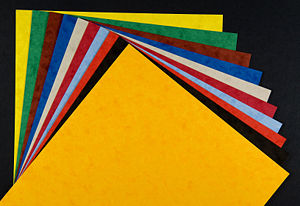
Card stock
Encyclopedia

Paperboard
Paperboard is a thick paper based material. While there is no rigid differentiation between paper and paperboard, paperboard is generally thicker than paper. According to ISO standards, paperboard is a paper with a basis weight above 224 g/m2, but there are exceptions. Paperboard can be single...
that is thicker and more durable than normal writing or printing paper
Paper
Paper is a thin material mainly used for writing upon, printing upon, drawing or for packaging. It is produced by pressing together moist fibers, typically cellulose pulp derived from wood, rags or grasses, and drying them into flexible sheets....
, but thinner and more flexible than other forms of paperboard
Paperboard
Paperboard is a thick paper based material. While there is no rigid differentiation between paper and paperboard, paperboard is generally thicker than paper. According to ISO standards, paperboard is a paper with a basis weight above 224 g/m2, but there are exceptions. Paperboard can be single...
. Card stock is often used for business card
Business card
Business cards are cards bearing business information about a company or individual. They are shared during formal introductions as a convenience and a memory aid. A business card typically includes the giver's name, company affiliation and contact information such as street addresses, telephone...
s, postcard
Postcard
A postcard or post card is a rectangular piece of thick paper or thin cardboard intended for writing and mailing without an envelope....
s, playing cards, catalog covers, scrapbooking
Scrapbooking
Scrapbooking is a method for preserving personal and family history in the form of a scrapbook. Typical memorabilia include photographs, printed media, and artwork. Scrapbook albums are often decorated and frequently contain extensive journaling...
, and other uses which require higher durability than regular paper. The texture is usually smooth, but can be textured, metallic, or glossy.
Card stock thickness is often described by pound weight. Pound weight is the weight of 500 sheets of 20 by paper. This differs from how text stock is determined, which assumes 500 sheets of 25 by paper. Most countries use the term grammage to describe the weight of the paper in grams per square metre. The term card stock is used to describe paper with weights from 50 lb to 110 lb (about 135 to 300 g/m²).
In the U.S., card stock thickness is usually measured in points or mils that gives the thickness of the sheet in thousandths of an inch. For example, a 10 pt. card is 0.01 in (0.254 mm) thick (roughly corresponding to a weight of 250 g/m2); 12 pt. is 0.012 in (0.3048 mm).
| 148
| 55
|
| 6
| 166
| 60
|-
| 8
| 184
| 70
|
| 8
| 201
| 75
|-
| 10
| 219
| 80
|
| 10
| 237
| 88
|-
| 12
| 247
| 90
|
| 12
| 265
| 98
|-
| 14
| 274
| 100
|
| 14
| 293
| 108
|}

